Full of flowerbeds, scenic views, museums, cultural attractions and leisure facilities, this is the city’s most popular and beloved park. Owned by the Borghese family for four centuries, in 1903 the princes’ garden became a park for the people of Rome after it was purchased by the Italian State and placed under Municipality of Rome management.
Cardinal Scipione, nephew of Pope Paul V, commissioned Villa Borghese just outside the city walls in the early 17th century. The 80-hectare park features a “Casino Nobile” (the modern-day Galleria Borghese), which today houses a rich collection of art. The Park’s many smaller buildings, originally used to manage the complex, have since been repurposed as museums and venues for cultural activities. Alongside an area arranged in geometric patterns and full of statues and fountains, the Cardinal was keen on creating prized “Secret Gardens” filled with rare flowers; he also set aside large areas for farming and hunting. Between the late 18th and early 19th centuries, Prince Marcantonio IV and his sons Camillo and Francesco transformed the park’s appearance and had it extended. Agricultural production was wound up, the park was enriched with spectacular architecture, and the more rustic buildings were upgraded to a luxurious style. The biggest change, however, was the transformation of a plantation of holm oaks into a “Lake Garden”. This feature was inspired by the canons of the English-style garden which, albeit later than in England, France and northern Italy, was gaining popularity in Rome. A long-running dispute between the family and the Italian State ended with the State purchasing the park and opening it to the public in 1903. With the exception of the Borghese Gallery, which remained under State management, the Municipality of Rome took over the complex and made further changes. During Fascism and World War II, the park’s layout was altered once again, with the addition of asphalt driveways, and removal of its gates and protective walls.
Highlights
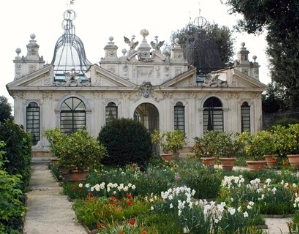
The Secret Gardens
The Cardinal and his nephew Giovanbattista commissioned three gardens on either side of the “Casino nobile”, enclosed on all sides to protect against indiscriminate use and the winter’s rigours. They were conceived to house rare plants and flowers, many from the Americas. In 2000, these gardens underwent meticulous restoration of the flower beds to their original design, including the planting of 17th-century flowers.
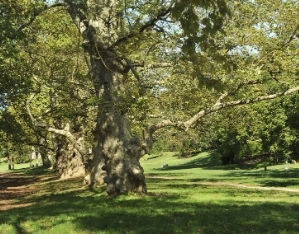
The Valley of the Plane Trees
In the more rustic part of this 17th-century park, a pleasant little valley once had a fishpond with black and white swans, surrounding by a grove of Platanus orientalis. Ten of these trees still grow today, true living monuments surrounded by trees unrelated to that original planting. The small “Casino del Graziano”, where the Cardinal and his guests used to stop on hunting trips, stands at the edge of the valley.
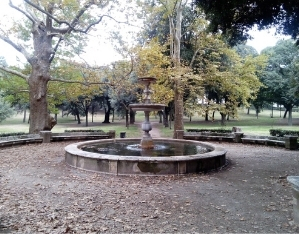
Fountains
The park has always had its fair share of spectacular fountains. Of the ones that have survived to the present day, two Fontane Oscure [dark fountains] are so called because they stand in the shade of holm oaks and plane trees; the spectacular Fontana dei Cavalli Marini [Fountain of the Seahorses], with four winged horses pawing at the water; the Fontana di Esculapio or del Fiocco [Fountain of Aesculapius or of the Flake], with a statue of the god and, originally, a particularly high jet of water; and the two fountains in the secret gardens, decorated with dragons and eagles, which are the Borghese family’s emblems.
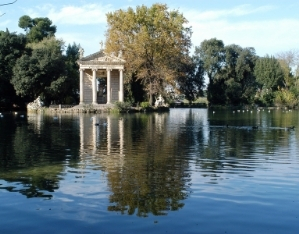
The Lake Garden
At the end of the 18th century, Marcantonio Borghese created Rome’s first English-style garden. Designed by Antonio and Mario Asprucci, it featured the work of many sculptors. Winding pathways, a lake, eclectic decor, and rare, exotic plants were incorporated into an old ilex grove. The Temple of Aesculapius, a classical building with sculptures associated with the myth surrounding the god of medicine, stands on a small island in the lake.
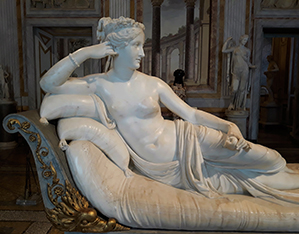
Museums
With its focus on cultural institutions, Villa Borghese is every bit as much a Museum as it is a Park. Galleria Borghese, the “Casino nobile” where the Cardinal began his collection with masterpieces by Raphael, Titian, Caravaggio, Bernini and Canova, is world famous. The Pietro Canonica Museum, in the Piedmontese sculptor’s former home, dates from 1960. Since 2006, the former Orangery has housed the Carlo Bilotti Museum, donated by the patron after whom it is named and featuring works by De Chirico, Warhol, Severini, and Manzù.
 Villa Borghese
Contacts
Villa Borghese
Contacts
Contacts
Telephone:+39 060608
Other contacts::General information on offices and services: + 39 06 6710 3238/3887
Address
Piazzale Napoleone I
00197, Roma (RM)
 Villa Borghese
Opening times and prices
Villa Borghese
Opening times and prices
Opening hours
The park of Villa Borghese is always open.
Pricing
Admission to the park of Villa Borghese is free.
The Secret Gardens of Villa Borghese can be visited by appointment:
- Cost of the visit: € 90,00
- We accept groups of max 30 people
- 90-minute visit
- Book at least 20 days before the requested date
 Villa Borghese
How to get there
Villa Borghese
How to get there
Address
Piazzale Napoleone I
00197, Roma (RM)
Latitude: 41.9027835
Longitude: 12.4963655
How to arrive by train
Get off at the train station (Roma- Viterbo) at piazzale Flaminio.
How to arrive by bus
- Bus no. 490, 495, 89, 160, 61. Get off at the stops in Via Fiorello La Guardia and Piazzale S. Paolo del Brasile.
- Bus no. 223, 910, 53, 63, 83, 92, 360 get off at the stop in via Pinciana at Galleria Borghese.
- Tram 19 and 3 with stops in via di Valle Giulia, via Ulisse Aldrovandi and via Rossini.
Additional directions
With the subway:
- Metro A: Flaminio and Spagna stops.
 Villa Borghese
Services/Accessibility
Villa Borghese
Services/Accessibility
Services
Games Area
- Viale Madama Letizia at the height of the entrance to the Giardino del Lago
- Viale Goethe, entrance from Viale San Paolo del Brasile, Daini Park, side of Via di Porta Pinciana
- Underground pay parking entrance from Piazzale San Paolo del Brasile and from Viale del Muro Torto
- Paid parking "blue stripes" in Piazzale Firdousi.
Inside the park of Villa Borghese there are many eateries, restaurants, cafeterias and kiosks, open from morning to night.
Pets are allowed. The dog area is located in Valle dei Platani, entrance from Viale delle Belle Arti.
Accessibility
- In order to enter Villa Borghese with your own vehicle, you need an entry permit, which can be obtained by sending a request by fax to the number 06 77204491, indicating the make of the vehicle, the number plate, the date, the place you want to reach, the name of the person making the request and the fax number for a reply.
- The cost of the permit is € 9.00 per day for each means of transport.
 Villa Borghese
Private events
Villa Borghese
Private events
 Villa Borghese
Itineraries
Villa Borghese
Itineraries
You could find the garden in these itineraries
 Favorite saving result
Favorite saving result
 Warning!
Warning!
You've have to sign up or sign in to add this element to your favorites.
